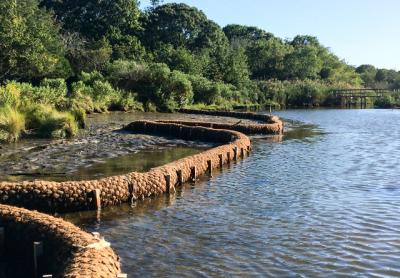Millions for Water at Stake in Tuesday Vote

East End voters will be asked on Tuesday to vote not only on national and state-level races, but also on Proposition 1, a referendum that would extend the Peconic Bay Region Community Preservation Fund program through 2050 and allow up to 20 percent of its proceeds to be used for water quality protection. Proponents say that the money would enable municipalities to jump-start long-needed programs and address a water pollution problem that has been well documented and studied. Opponents say more time is needed to analyze the problems and develop scientifically sound solutions, and that towns could raise money for improvement in other ways, including borrowing. They also say that rules for spending the new preservation fund money should be in place before it is diverted.
The referendum will be found on the reverse side of the paper ballots that voters will receive.
Toxic algal blooms and other pollutants that have caused periodic closures of local waters, impacts to fish and shellfish, and problems with drinking water have focused recent attention on the need to address ground and surface water pollution.
If Proposition 1 is approved, wastewater treatment, agricultural pollution control and abatement, aquatic habitat restoration, and other pollution prevention projects could be paid for by the preservation fund, which receives the proceeds of a 2-percent real estate transfer tax.
In preparation for the referendum, each of the East End towns has drafted a plan with proposed projects. Water testing, to establish a baseline showing the state of surface or groundwater before any improvement efforts, would likely top the to-do list in East Hampton, Councilman Peter Van Scoyoc said this week.
Projects to reduce runoff, which carries pollutants directly into water bodies, could also be high on the list of projects, Mr. Van Scoyoc said. Some projects, such as the restoration around Pussy’s Pond in Springs, are already under way, using money obtained by the town through grants from the state or elsewhere.
The councilman also mentioned habitat restoration to bolster shellfish stocks — perhaps an expansion of the town hatchery’s oyster garden program, or the installation of oyster reefs — and adding another pump-out station to keep boaters from dumping septic waste into harbors, as undertakings that could begin soon if the referendum is approved.
A rebate program to encourage homeowners to install new-technology septic systems that remove nitrogen from wastewater, and the installation of neighborhood waste treatment systems in ecologically sensitive areas, both seen as key to addressing nitrogen pollution, would require more time to craft and implement.
East Hampton’s 65-page plan outlines conditions and includes recommendations for projects in eight watersheds of concern, prioritized according to what might be accomplished over the next decade. Projects must comply with the town’s zoning and comprehensive plans, and result in a measurable improvement in water quality or aquatic habitat.
Based on last year’s income to the preservation fund, had the 20 percent portion been available for use, East Hampton would have had over $6 million to address water pollution problems, town officials have estimated.
Proposition 1 has been supported by a coalition of dozens of environmental and other civic groups, which formed the Clean Water and Community Preservation Committee to campaign for it, including the Citizens Campaign for the Environment, Peconic Land Trust, the Group for the East End, the Nature Conservancy, and the Peconic Baykeeper.
During the first three quarters of this year, East Hampton Town collected $21.5 million from the regional C.P.F. for its own community preservation fund, an increase of nearly 5 percent over last year. Income to the fund as a whole, from all five East End towns combined, showed a decrease.
Each township receives proceeds from the tax on real estate transactions within its own boundaries. The future of each town’s C.P.F. — whether water quality improvement projects will be eligible, and whether the lifespan of the fund itself will be extended by 20 years to 2050 — will depend on the results of that town’s vote.
